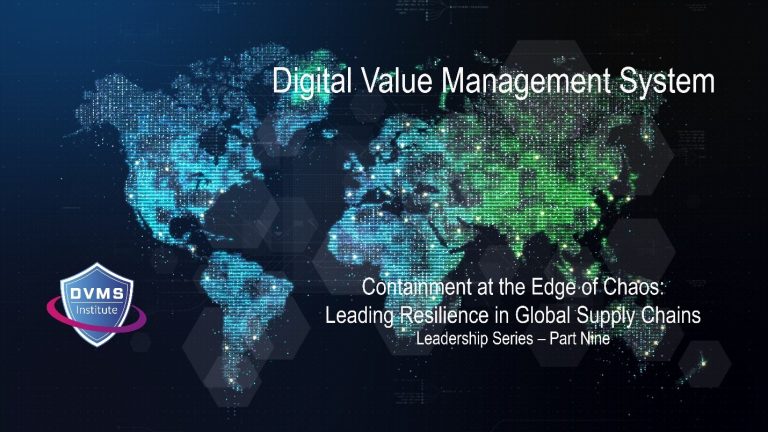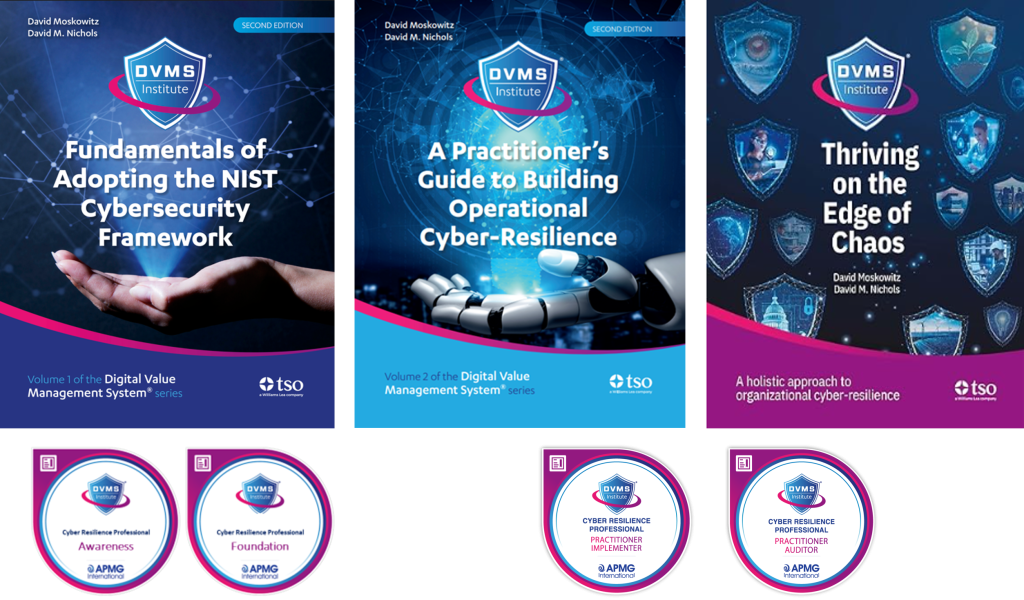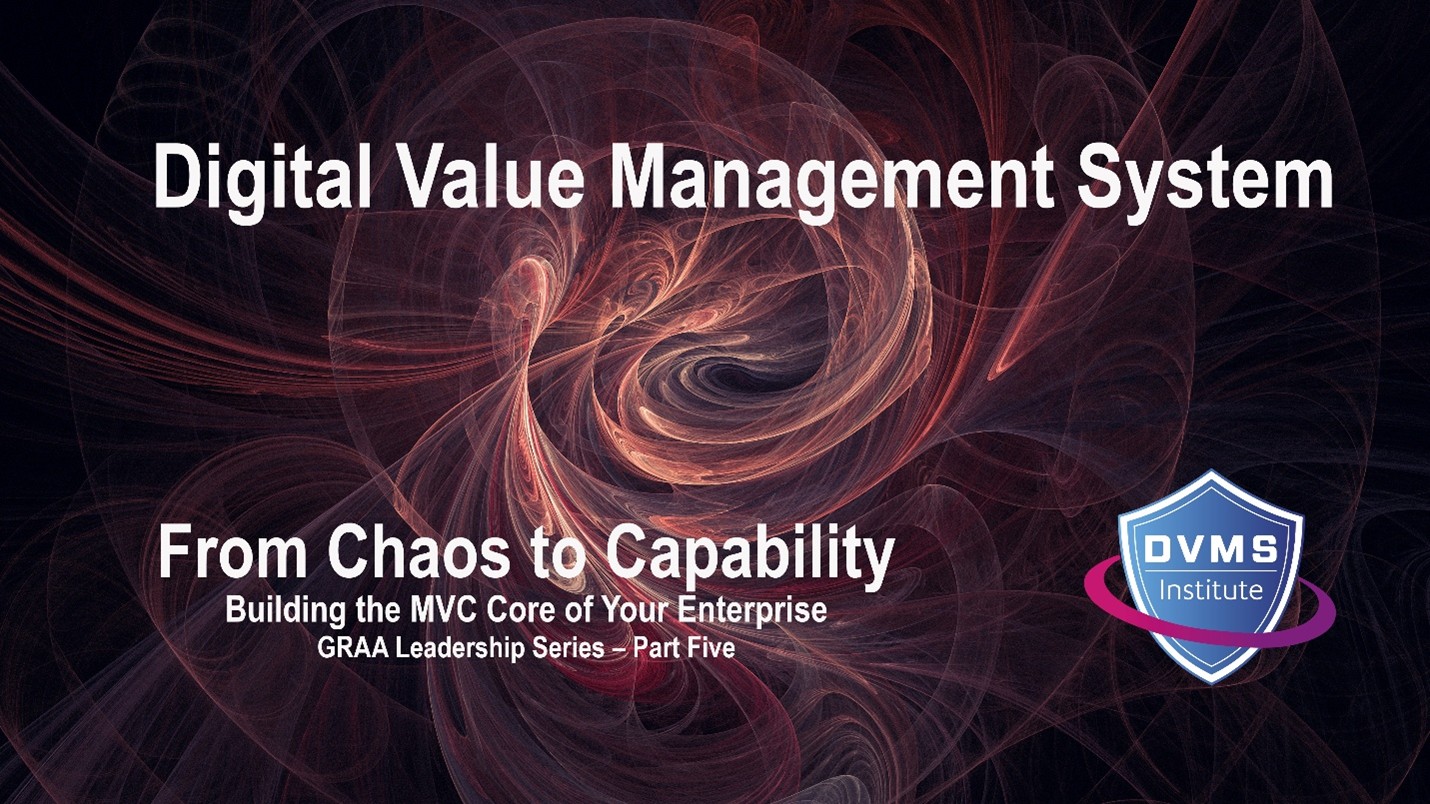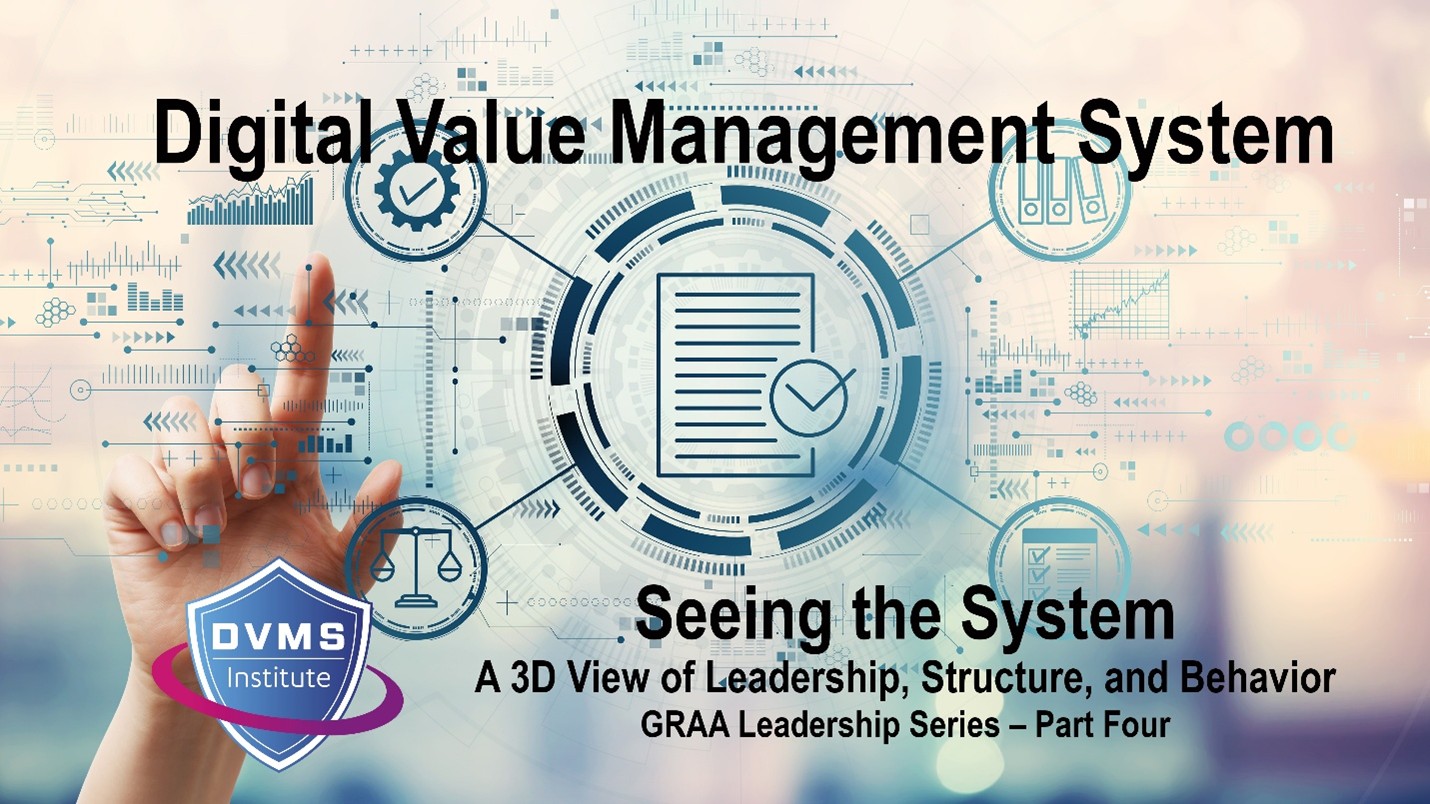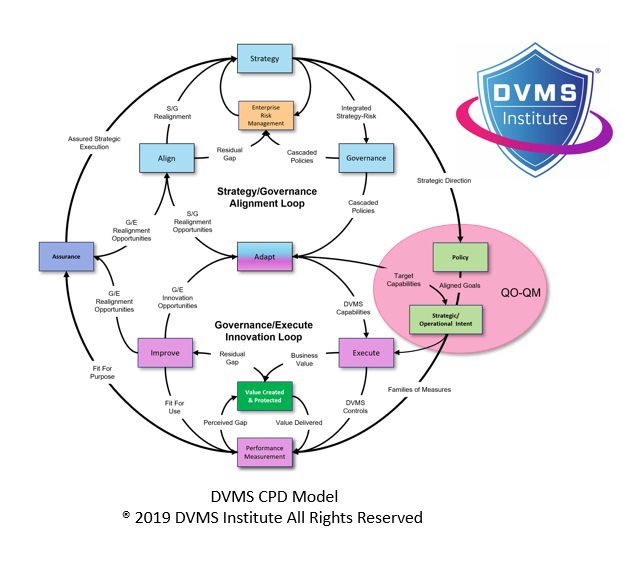Containment at the Edge of Chaos: – Leading Resilience in Global Supply Chains – A Leadership Call to Action – Part Nine
David Nichols – Co-Founder and Executive Director of the DVMS Institute
From the Organization to the Supply Web
In Part Eight, we examined how the boundary of chaos is expanding into new areas, including artificial intelligence, digital ethics, stakeholder trust, and societal expectations. We found that leading at the edge requires more than intuition; it demands transparency into interdependencies and the bravery to bridge cultural gaps.
In Part Nine, the focus shifts to supply webs — the complex, interconnected networks that support modern economies. I’ll use the full term “edge of chaos” throughout, but as in earlier sections, I’ll sometimes abbreviate it to “the edge” for simplicity.
Supply chains are no longer linear. They have evolved into supply webs: extensive, flexible, and interconnected worldwide. In these webs, efficiency and vulnerability are two sides of the same coin. A disruption at one point can spread unpredictably across the entire system. As we saw during the COVID-19 pandemic, for leaders, the key takeaway is that resilience can no longer depend solely on contracts, assumptions, or redundancy. Instead, it must be built on containment and evidence-based relationships.
Containment involves limiting risk through proof rather than promises. Evidence-based relationships require suppliers to demonstrate their capabilities under pressure. This paper examines how leaders at the edge of chaos create, maintain, and scale supply web resilience in an environment where disruption is unavoidable.
The Edge of Chaos in Global Supply Webs
The old metaphor of a supply “chain” implied linearity and predictability. That metaphor no longer fits. Today’s supply webs are multidimensional systems, with overlapping relationships, shared dependencies, and global exposure. They are optimized for efficiency but vulnerable to disruption.
In such webs, leadership is tested not by routine operations but by shocks: a factory fire in Asia that halts production in Europe; a cyberattack on a logistics provider that impacts healthcare; or a geopolitical conflict that transforms entire industries overnight. Each event uncovers the same truth: the edge of chaos in supply webs is where stability and adaptability must coexist.
The DVMS approach redefines supply web resilience as a leadership challenge. Leaders must coordinate value, risk, and culture not only within their organizations but also across their networks of partners and suppliers. The question is not just whether goods flow, but whether the supply web can adapt without breaking under pressure.
Containment as the Strategic Imperative
Containment is the discipline of limiting risk through demonstrable evidence. In the DVMS sense, containment asks: Can this supplier prove, with evidence, that they can meet our needs under stress? It rejects vague assurances and demands verifiable capability.
Consider two organizations facing the same disruption. One believed it was resilient because it had multiple suppliers. Yet when disruption struck, it discovered those suppliers shared the same upstream vulnerabilities. Redundancy without containment proved to be an illusion.
The other organization viewed resilience as something supported by evidence rather than assumptions. Its leaders required suppliers to prove resilience through audited processes, recovery plans, and transparent performance data. When the disruption occurred, the gaps were already identified, and contingency plans were already in place. Instead of panicking, they managed the risk effectively.
Leadership’s role here is crucial. Containment doesn’t happen by luck; it depends on executives to set clear expectations, demand proof, and ensure partners are held responsible. They must treat resilience as a core part of creating value, not just an afterthought. Without firm leadership, containment risks turning into empty compliance gestures.
Evidence-Based Relationships in the Supply Web
Containment relies on transparency and evidence in relationships. Trust is essential, but blind trust doesn’t build resilience.
This is where culture becomes essential. Leaders must cultivate a culture where suppliers are expected — and rewarded — for providing clear evidence of their capabilities. Cultural behaviors that punish escalation or reward secrecy weaken resilience; those that promote transparency and learning strengthen it.
The Adaptive Edge Platform, guided by Kaia, the AI agent, helps leaders navigate this landscape. Kaia does not make decisions for them but serves as an advisor, highlighting the connections between leadership intent, structures, and behaviors. She can reveal, for example, when leadership rhetoric about transparency is undermined by contractual incentives that incentivize silence, or when cultural gaps prevent suppliers from surfacing risks.
Kaia also emphasizes the skills needed to maintain evidence-based relationships. Hard skills include supplier auditing, analytics, and regulatory literacy. Soft skills encompass diplomacy, empathy, and building trust across cultures. By highlighting these requirements, the Adaptive Edge Platform simplifies the complex systems matrix into a clear pathway that leaders can confidently follow.
The result is not just a more robust supply network but a stronger culture of partnership. Suppliers cease being vendors with contracts and begin to act as partners in resilience, tied not by promises but by evidence.
Patterns of Success and Failure at the Edge of Chaos
Across industries, patterns emerge.
Organizations that succeed in supply web resilience integrate containment and evidence-based relationships into their culture. Leaders demand demonstrable proof, incorporate transparency into governance, and embed trust into daily practices. These organizations view resilience not as a separate program but as a core aspect of how value is created and delivered.
Organizations that neglect to prioritize resilience treat it as a mere checklist. They depend on contracts and redundancy, trusting that backup suppliers will be enough. When disruption occurs, their failure to contain the problem becomes clear. Evidence was never required, gaps were never addressed, and trust crumbles exactly when it’s needed most.
Assimilation remains the key difference. In mergers, it meant enriching cultures. Supply webs involve integrating containment and evidence into core operations. When leaders assimilate resilience into their leadership style, supply webs adapt and recover. When they don’t, these webs fracture under pressure.
The Adaptive Edge Platform facilitates this understanding by revealing interdependencies that leaders might overlook. Kaia shows where leadership signals conflict with organizational structures, cultural behaviors oppose resilience objectives, and skill gaps leave vulnerabilities unaddressed. By making the unseen visible, Kaia enables leaders to shift from reactive improvisation to proactive orchestration at the edge of chaos.
Practical Tools for Executives
Part Nine must stay practical. Leaders should extend the Z-axis audit from Part Six into their supply networks by asking: Does our leadership intent match our structures and behaviors in supplier relationships? Where is there misalignment, and what needs to change?
The CPD Model also applies directly:
- Create: strategic partnerships that add value and strengthen resilience.
- Protect: insistence on containment and demonstrable evidence from suppliers.
- Deliver: sustained trust and performance across the web.
Asking these questions regularly simplifies the complex global supply network into a clear understanding.
The Adaptive Edge Platform enhances these practices by offering evidence-based visibility. Kaia does not provide solutions. Instead, she advises leaders by pointing out hidden dependencies, cultural gaps, and necessary skills. By simplifying the systems matrix into a straightforward path, Kaia turns the edge of chaos from a source of fear into a landscape that leaders can confidently navigate.
Toward a Global Paradigm
Part Nine has focused on supply webs, where the edge of chaos is felt most deeply. It has been demonstrated that containment and evidence-based relationships are not merely technical solutions, but essential leadership tools. Leaders who demand measurable resilience build webs capable of withstanding disruption and adapting to change. Those who depend on promises and redundancy tend to struggle.
But the edge of chaos continues to expand. Beyond supply webs lie global ecosystems, cross-border regulations, and interconnected societies where resilience and legitimacy are tested at a large scale. Part Ten will bring together all the aspects discussed in this series — culture, governance, resilience, AI, ethics, trust, societal expectations, and supply webs — into a worldwide leadership model.
Part Nine reminds us that leadership on the edge of chaos is not about predicting disruptions but about preparing for them through containment and evidence. It emphasizes demonstrating resilience rather than assuming it. It also involves leading supply webs not as chains of contracts but as ecosystems based on trust, accountability, and adaptive strength.
About the Author

Dave is the Executive Director of the DVMS Institute.
Dave spent his “formative years” on US Navy submarines. There, he learned complex systems, functioning in high-performance teams, and what it takes to be an exceptional leader. He took those skills into civilian life and built a successful career leading high-performance teams in software development and information service delivery.
Digital Value Management System® (DVMS)
The DVMS is a living management overlay system that supports:
- Governance for sustainable digital outcomes through risk-informed decision-making
- Resilience through a culture designed to create, protect, and deliver digital value
- Assurance through outcome-based measurement of intended digital outcomes
- Accountability and transparency across complex digital ecosystems
At its core, the DVMS is a simple but powerful integration of:
- Governance Intent – shared expectations and accountabilities
- Operational Capabilities – how the digital business actually performs
- Assured Evidence – proof that outcomes are achieved and accountable
Rather than adding complexity, a DVMS integrates:
- Fragmented Frameworks and Practices —such as NIST CSF, GRC, ITSM, DevOps, and AI—into a unified management overlay that enables leaders and regulators to see, continuously, whether the digital business is operating as intended— and whether the risks that matter most are being proactively managed
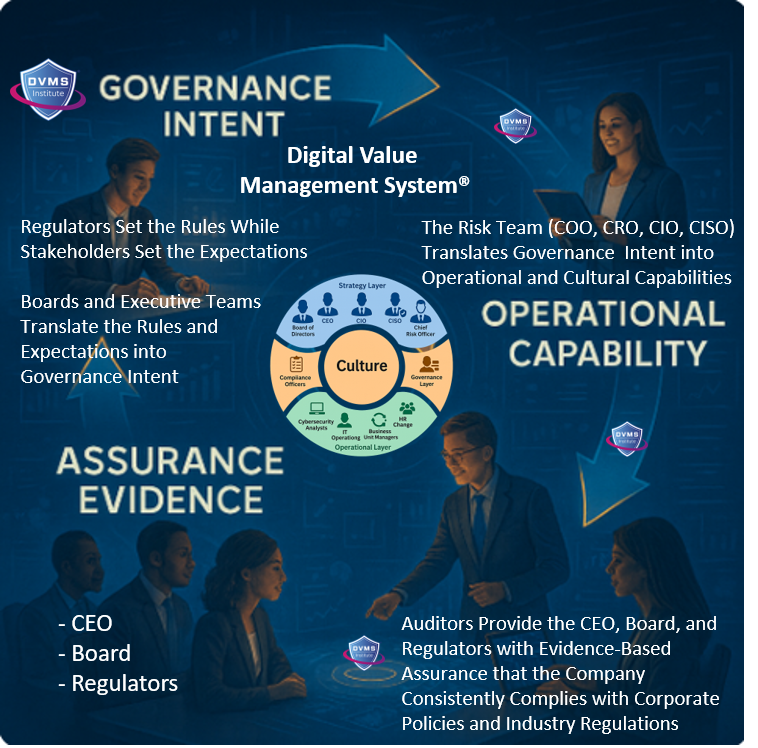
Through its MVC, CPD, 3D Knowledge, and FastTrack Models, a DVMS turns this integration into three distinctive capabilities:
A Governance Overlay that replaces fragmentation with unity. The DVMS provides organizations with a structured way to connect strategy with day-to-day execution. Leaders gain a consistent mechanism to direct, measure, and validate performance—across every system responsible for digital value.
A Behavioral Engine that drives high-trust, high-velocity decision-making. The DVMS embeds decision models and behavioral patterns that help teams think clearly and act confidently, even in uncertain situations. It is engineered to reduce friction, prevent blame-based cultures, and strengthen organizational reliability.
A Learning System that makes culture measurable, adaptable, and scalable. Culture becomes a managed asset—not an abstract concept. The DVMS provides a repeatable way to observe behavior, collect evidence, learn from outcomes, and evolve faster than threats, disruptions, or market shifts.
DVMS Organizational Benefits
Instead of replacing existing operational frameworks, the DVMS elevates them—connecting and contextualizing their data into actionable intelligence that validates performance and exposes the reasons behind unmet outcomes.
By adopting a DVMS, organizations are positioned to:
- Maintain Operational Stability Amidst Constant Digital Disruption
- Deliver Digital Value and Trust Across A Digital Ecosystem
- Satisfy Critical Regulatory and Certification Requirements
- Leverage Cyber Resilience as a Competitive Advantage
DVMS Leadership Benefits
The Digital Value Management System (DVMS) provides leaders with a unified, evidence-based approach to governing and enhancing their digital enterprise, aligning with regulatory requirements and stakeholder expectations.
For the CEO, the DVMS provides a clear line of sight between digital operations, business performance, and strategic outcomes—turning governance and resilience into enablers of growth and innovation rather than cost centers.
For the Board of Directors, the DVMS provides ongoing assurance that the organization’s digital assets, operations, and ecosystem are governed, protected, and resilient—supported by evidence-based reporting that directly links operational integrity to enterprise value and stakeholder trust.
For the CIO, CRO, CISO, and Auditors: an integrated, adaptive, and culture-driven governance and assurance management system that enhances digital business performance, resilience, trust, and accountability
DVMS White Papers
The three whitepapers below present a coherent progression that shifts organizations from compliance-driven thinking to a modern system of Governance, Resilience, Assurance, and Accountability (GRAA). Collectively, the three papers define a comprehensive system for building and governing resilient digital enterprises, grounded in evidence rather than assumptions.
The Assurance Mandate Paper sets the stage by showing why traditional GRC artifacts provide only reassurance—not evidence—and calls boards to demand forward-looking proof that their organizations can continue to create, protect, and deliver value under stress.
The Assurance in Action Paper elevates the conversation from leadership intent to managerial execution, demonstrating how the DVMS operationalizes resilience by translating outcomes into Minimum Viable Capabilities, connecting frameworks through the Create–Protect–Deliver model, and generating measurable assurance evidence that managers can use to demonstrate real performance rather than activity.
The Governing by Assurance Paper elevates the approach to the policy and regulatory level, showing how DVMS functions as a learning overlay system that links governance intent, operational capability, and verifiable evidence into a continuous loop—enabling regulators, agencies, and enterprises to govern by outcomes rather than checklists and to prove capability with measurable, auditable performance data.
DVMS Cyber Resilience Certified Training Programs
DVMS Cyber Resilience Awareness Training
The DVMS Cyber Resilience Awareness course and its accompanying body of knowledge publication educate all employees on the fundamentals of digital business, its associated risks, the NIST Cybersecurity Framework, and their role within a shared model of governance, resilience, assurance, and accountability for creating, protecting, and delivering digital value.
This investment fosters a culture that is prepared to operate within a system capable of transforming systemic cyber risks into operational resilience.
DVMS NISTCSF Foundation Certification Training
The DVMS NISTCSF Foundation certification training course and its accompanying body of knowledge publications provide ITSM, GRC, Cybersecurity, and Business professionals with a detailed understanding of the NIST Cybersecurity Framework and its role in a shared model of governance, resilience, assurance, and accountability for creating, protecting, and delivering digital value.
This investment fosters IT, GRC, Cybersecurity, and Business professionals with the skills to operate within a system capable of transforming systemic cyber risks into operational resilience.
DVMS Cyber Resilience Practitioner Certification Training
The DVMS Practitioner certification training course and its accompanying body of knowledge publications teach ITSM, GRC, Cybersecurity, and Business practitioners how to elevate investments in ITSM, GRC, Cybersecurity, and AI business systems by integrating them into a unified governance, resilience, assurance, and accountability system designed to proactively identify and mitigate the cyber risks that could disrupt operations, erode resilience, or diminish client trust.
This investment fosters IT, GRC, Cybersecurity, and Business practitioners with the skills to assess, design, implement, operationalize, and continually innovate a Digital Value Management System® program that operationalizes a shared model of governance, resilience, assurance, and accountability for creating, protecting, and delivering digital value.
Company Brochures and Presentation
Explainer Videos
- DVMS Architecture Video: David Moskowitz explains the DVMS System
- DVMS Case Study Video: Dr. Joseph Baugh Shares His DVMS Story.
- DVMS Overlay Model – What is an Overlay Model
- DVMS MVC ZX Model – Powers the CPD
- DVMS CPD Model – Powers DVMS Operations
- DVMS 3D Knowledge Model – Powers the DVMS Culture
- DVMS FastTrack Model – Enables A Phased DVMS Adoption
Digital Value Management System® is a registered trademark of the DVMS Institute LLC.
® DVMS Institute 2025 All Rights Reserved

